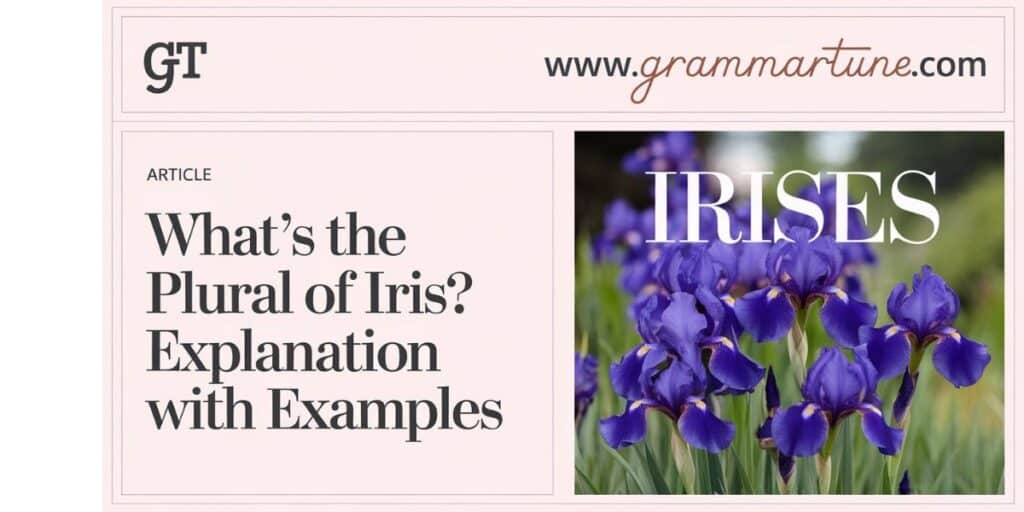What is the Plural of Iris? Sounds simple, but it depends on the context-biology and grammar-whenever you talk about them. Both are important for growing iris flowers or for communicating the iris aspect of the human eye.
The guide will also enlighten you on the proper use, the meaning of some common mistakes, and interesting facts associated with the term. Furthermore, it will educate you about the linguistic rules, Latin etymologies, and current usage that shape how we say the plural of iris in specific situations.
📘 Main Topics
- 🌸 What is the Plural of Iris?
- ❓ Why Are the Plurals ‘Irises’ and ‘Irides’?
- 🌼 What is an Iris?
- ✍️ Using ‘Iris’ in Sentences (Singular Usage)
- 📝 Using ‘Irises’ and ‘Irides’ in Sentences (Plural Usage)
- ✅ Usage of “Irises”
- 🔬 Usage of “Irides”
- 🧬 Origins of the Word ‘Iris’
📚 Extra Details & Guides
- 📖 Definition and the Plural of Iris
- 📅 When to Use Iris and the Plural of Iris
- ✏️ Examples of Iris and the Plural of Iris in Sentences
- 🎭 Cultural References
- 🔠 Plural Forms of Iris
- ⚡ Quick Facts
- 🔍 When to Use Irides vs. Irises
- 🧠 Tip Table for Usage
- 🚫 Common Mistakes and How to Avoid Them
- 🎉 Fun Facts about Irises
- ❓ FAQs
What is the Plural of Iris?
The plural of iris can be tricky. You’ll often hear both irises and irides, but they aren’t always interchangeable. The right form depends on what you’re talking about.
Botanically, irises is the standard plural. But in some contexts, especially scientific or poetic, irides appear. It’s less common in everyday speech.
Must read: Forward vs Forwards: Which One Should You Use?
Why Are the Plurals ‘Irises’ and ‘Irides’?
Language evolves, and the word iris took two different paths. Irises follow standard English rules. Irides stems from the word’s Latin and Greek roots.
Each form has its place. Irides is rarer and often found in academic or descriptive writing. Irises are what you’ll see in flower shops and gardens.
What is an Iris?
An iris is either a beautiful flowering plant or the colored part of your eye. It’s a word with multiple meanings based on the context. The plant version is more common in everyday conversation.
The eye’s iris controls how much light enters. In both cases, the iris stands out for its color. Its name even comes from the Greek word for “rainbow.”
Using ‘Iris’ in Sentences (Singular Usage)
When using iris in the singular, clarity matters. “I saw a purple iris in the garden” refers to the flower. “Her iris sparkled under the sun” refers to the eye.
Context clues tell readers which meaning you’re using. Stick to one sense per sentence. That keeps communication smooth and clear.
Using ‘Irises’ and ‘Irides’ in Sentences (Plural Usage)
“Irises” works in most plural uses. “I planted five irises last spring” is a natural sentence. Use it when referring to multiple flowers or eyes.
“Irides,” on the other hand, fits poetic or scientific language. “The irides of the birds shimmered like jewels” sounds more literary. Choose based on tone and audience.
Usage of “Irises”:
You’ll find irises in gardening books, florist websites, and biology classes. It’s the go-to plural for most speakers. No confusion, just standard usage.
It’s also used for eye color in some contexts. “Brown irises are common worldwide” is grammatically correct. Keep it simple unless you need a fancier touch.
Usage of “Irides”:
Irides is less common, but still correct. It appears in medical texts or poetic writing. “The doctor examined both irides for trauma” is medically precise.
Writers may choose it for rhythm or style. But it can sound out of place in casual speech. Use with care and intention.
Origins of the Word ‘Iris’
The word iris has ancient roots. It comes from the Greek goddess Iris, who personified the rainbow. That fits both meanings—flowers and eye colors.
From Greek to Latin, and finally into English, iris carried its vibrant meaning. It reflects color, light, and beauty. A rich history for a simple word.
Definition and the Plural of Iris
An iris is a noun with dual meanings. It refers to either a flower or part of the eye. The plural forms are irises and irides.
Knowing which one to use matters. Irises fit most everyday situations. Irides adds a bit of flair or precision in the right context.
When to Use Iris and the Plural of Iris
Use iris when talking about one flower or eye. Use irises when there’s more than one. Choose irides only for specialized or poetic writing.
It’s all about the tone and setting. Stick with irises for general use. Save irides for when the moment calls for elegance.
Examples of Iris and the Plural of Iris in Sentences
Iris: “She painted an iris blooming in the corner.”
Irises: “We spotted blue irises near the river.”
Irides: “Their irides reflected the morning light.”
Each sentence changes with the plural form. Understanding these helps you write more clearly. Use the version that fits your message best.
You will like: What’s the Past Tense of Cost: Is It Cost or Costed?
Cultural References
The iris has deep symbolism in many cultures. It often represents wisdom, courage, or hope. You’ll see it in art, literature, and even royal emblems.
In Japan, irises symbolize purification and protection. In France, the fleur-de-lis is inspired by the iris. A flower with beauty and meaning.
Plural Forms of Iris:
- Irises – Standard English plural (most common)
- Irides – Latin/Greek-rooted plural (less common)
Both are correct depending on context. Don’t overthink it—irises are usually the safe choice.
Quick Facts:
- “Irises” = Most commonly used plural
- “Irides” = Rare, often scientific or poetic
- Rooted in Greek mythology (goddess of the rainbow)
Short, sweet, and colorfully confusing—but now you’ve got it covered.
When to Use Irides vs. Irises
Use irides in anatomy or poetic imagery. It sounds refined and specific. But it might confuse casual readers.
Irises is familiar and widely accepted. It works for both flowers and eyes. When in doubt, choose irises.
Tip Table for Usage:
| Situation | Correct Plural |
| Talking about flowers | Irises |
| Medical or anatomical | Irides |
| Everyday conversation | Irises |
| Literary or poetic | Irides |
This quick guide helps you pick the right word fast.
Common Mistakes and How to Avoid Them
People often use irides when they mean irises, or vice versa. Mixing them up can sound awkward. Know your audience and pick the simpler form when in doubt.
Avoid using irides for flowers—it sounds odd. Also, don’t force either one into a sentence. Let the tone guide your word choice.
Fun Facts about Irises
Some 300 species of iris flowers exist. Vincent van Gogh painted numerous iconic irises, and no two human irises are exactly alike- just like fingerprints.
In Greek mythology, Iris was the messenger of the gods, and her name stood for the rainbow. A most fitting legacy for such a colorful word.
You will like: Igniter or Ignitor: Which Spelling Should You Choose?
FAQ’S
What’s the correct plural of iris—irises or irides?
Both are correct, but context matters. Irises is the standard plural form used for flowers and eyes in most situations. Irides is more technical or poetic and is mainly used in medical or literary writing.
Can I use “irises” when talking about eyes?
Yes! Saying “She has bright blue irises” is perfectly acceptable. It’s clear, conversational, and widely understood.
When should I use “irides”?
Use irides in formal, scientific, or artistic contexts. For example, “The doctor examined the patient’s irides” or “The bird’s shimmering irides caught the light.”
Is “iris” only a flower?
No, the word iris refers to both a flower and the colored part of the eye. It all depends on the sentence and setting.
Why does “iris” have two plural forms?
Because iris has Latin and Greek origins. English borrowed the word and adapted it over time, creating both irises (regular English plural) and irides (from its classical roots).
Conclusion
Understanding What’s the Plural of Iris? clears up a surprisingly common confusion. Whether you choose irises for everyday use or irides for more formal writing, both forms are correct in their own right.
Context is everything. If you’re talking about flowers or eyes in a casual setting, stick with irises. Save irides for scientific or poetic moments. Knowing the difference helps you write with clarity and confidence. Now that you’ve seen clear examples and usage tips, using the correct plural of iris should feel natural and easy.

Joulia, a seasoned wordsmith and grammar enthusiast, brings over a decade of blogging expertise to Grammar Tune. With a keen eye for linguistic precision and a passion for making complex grammar concepts accessible, he has helped thousands of readers enhance their writing skills. His engaging teaching style and practical approach to language learning have made him a trusted voice in the online grammar community.







